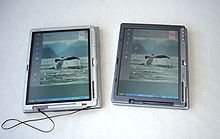Fujitsu Lifebook
Lifebook (official spelling LIFEBOOK ) refers to the notebook series from Fujitsu Technology Solutions (formerly Fujitsu Siemens Computers ) , which is aimed at business customers. These differ from the consumer series, for example, in that the drive bay can be expanded modularly and the possibility of connecting a port replicator . The series are divided into the series Lifebook A, B, C, E, P, S, Q and T. The naming of the series is, similar to that of the mobile phones from Siemens AG , originally from the series of Mercedes-Benz Car ajar. The series are manufactured by Fujitsu itself, in contrast to the Amilo series , which is largely bought in.
Class names
All series, including former ones, are listed here; Currently (2017) the Lifebook A series is more likely to be continued for the cheaper private sector and the series E, P, S, T, U mostly more for the business sector. Fujitsu is traditionally strong in the touchscreen and tablet area (in the Lifebook S, T, and U series). In addition, reference is made to the Stylistic series.
Lifebook A
The A series was introduced in 2010 and initially consisted of the "all-round" models A530, AH530 and AH550, which are offered in different versions. Similarities were displays with 39.6 cm (15.6 inch) diagonal, LED backlighting and 1366 × 768 pixels ( image format 16: 9 , with or without glare protection), as well as the built-in chipset Intel HM55 and keyboards with numeric keypad . The devices are offered with mobile processors mainly from the Intel Core-i series . Even today (2017) the A-series, for example with the models A555 and A557, are relatively inexpensive larger laptops (15.6 inches) that are offered as "all-rounders" or as private laptops.
Lifebook B
The B series was the Biblo class for subnotebooks. The first models (B110 and B112, 1998) were very compact (DIN A5 size and 1.1 kg) and had an 8.4 "color display. The special thing about the larger (DIN A4 format) successor models B213x (1999) was the 10.4 "touch-sensitive TFT screen and stylus. The B series is no longer built and has been replaced by the T series and P series.
Lifebook C
The C series was the entry-level series for professional users until 01/2008. It was constructed in a simple and robust manner, but some additional options such as 3D graphics cards were not available, and it hardly differed from the E series in terms of appearance.
Lifebook E
The E series is a range of desktop replacement notebooks. They are particularly robust and usually have more powerful components than the C series (faster processors, more RAM, etc.), which is also reflected in the price. The E series usually has a higher quality, high-contrast 15 / 15.4-inch screen that is specially designed for office use, as no reflective displays are used and mostly 4: 3 formats are available.
Lifebook NH
46.7 cm screen width. Multimedia and gaming.
Lifebook P
Several ultraportable notebooks are available under the P series . This includes B. the P1620, which with a weight of 1 kg is one of the lightest convertible tablet PCs . The P stands for Piccolo .
Lifebook Q
The Q series are lifestyle notebooks that stand out from the other series with their piano lacquer and ergonomic stainless steel design and are intended to appeal to a discerning group of buyers. This series is especially optimized for mobile operation, which is why only ultra-low-voltage processors of the Intel Core architecture are used, the main memory is firmly soldered and two batteries with a runtime of more than 10 hours can be used.
Lifebook S
The S series is a notebook series that was originally intended for frequent travelers. The performance is roughly comparable to that of the E series, but the construction is a bit lighter and the notebooks are smaller thanks to 14/13 inch displays.
Lifebook T
The T series consists of convertible tablet PCs. By rotating the screen, they turn into a "tablet". The T stands for tablet here. The T series was introduced in September 2003 with the T3010, which was the most powerful tablet PC and the first ever convertible from FTS when it was launched. FTS had been building computers ( Stylistic ) that could be operated with a pen for a long time , but these were only suitable for pen input without additional devices (cf. slate tablet PCs).
The T4210 was launched in June 2006 and was the first tablet PC with an Intel Core Duo processor. The Toshiba Tecra M7 was launched about a month later. The LIFEBOOK T4215 was the first convertible tablet PC with embedded UMTS. Currently (2017) the T936 and T937 are slim but powerful 'convertibles' in the range.
Lifebook U
In May 2007, Fujitsu Japan introduced an extremely small and lightweight convertible tablet PC. The device, which weighs only 580 g, was marketed as the UMPC and is about the size of a PDA . Today (2017), high-performance notebooks that are light but not extremely small and that usually have a 13.3 inch or 14 inch screen diagonal are sold in the series (U747, U757, U937).
Other series
Other series from Fujitsu are:
- Esprimo Mobile - affordable business series
- Amilo-PRO - another inexpensive business series
- Amilo - consumer series; also with special variants for computer gamers
- Celsius - mobile workstations especially for CAD etc.
- Stylistic ST - pen-operated computers (slate tablet PCs) without a keyboard
- NH - Laptops with a screen width of 46.7 cm, for multimedia and gaming




